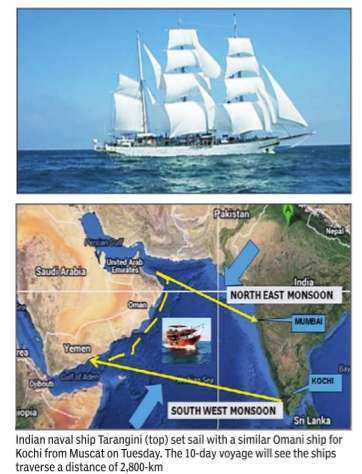INDIAPOSITIVE
ELITE MEMBER

- Joined
- Sep 20, 2014
- Messages
- 9,318
- Reaction score
- -28
- Country
- Location
SOURCE: TNN

The battle for geopolitical influence has been joined on the high seas in right earnest. India’s old spice route is now jostling with China’s ancient silk route for the same strategic space in the Indian Ocean Region (IOR) in modern times.
The eye-catching Indian naval sail ship, Tarangini, set sail with a similar Omani ship, Shabab Oman, for Kochi from Muscat on Tuesday , which will see them traverse a distance of 1,500 nautical miles (2,800-km) during the 10-day voyage. The two ships sailing together, in celebration of 60 years of diplomatic relations being established between India and Oman, will retrace historical voyages of yore undertaken by dhows and trading vessels between the ports of the two countries.
“The ships then took advantage of favourable seasonal winds, which are called mausam’ in Arabic. The flourishing trade of spices and garments from India, and dates and gold from Oman, nourished the two civilisations, developing cultural and trade linkages over many centuries,” said an officer.
Tarangini, which reached Muscat on Sunday after a long trip to Europe, and Shabab will arrive at Kochi to “a grand welcome” on December 3-4. The “togetherness voyage” neatly dovetails into India’s Project Mausam, which seeks to revive its ancient economic and cultural links with countries in the IOR with a new strategic focus.
Project Mausam, of course, also intends to coun ter China’s expanding stra tegic footprint with its Mari time Silk Road and other initiatives to garner eco nomic and political influen ce from Southeast Asia to the Middle East. “The aim now is to pro-actively engage with all IOR countries, stepping up maritime and strategic ties,” said another officer.
But India has been quite slow to play catch-up with China, which has systematically forged maritime links from East Africa, Seychelles, Mauritius and Maldives to Sri Lanka, Bangladesh, Myanmar and Cambodia. “Another problem is our lack of followthrough in the promises made to IOR countries,” admitted another officer.
Even though China is mainly trying to ensure protection of its sea lanes for its expanding energy needs, it does also amount to a strategic encirclement of India.The frequent forays by Chinese conventional and nuclear submarines in the IOR over the last year have only served to further accentuate concerns here.
With Project Mausam, India hopes to get some winds back into its geopolitical sails. A key trading partner in the Gulf region with bilateral trade hovering around $6 billion and a 7,00,000-strong Indian expatriate community, Oman is a good place to begin with. The two countries have also institutionalised their “Sea Breeze” and “Naseem-Al-Bahr” naval exercises and “Eastern Bridge” and “Al Jisr Al Sharqi” air exercises as they step up bilateral defence cooperation.
The battle for geopolitical influence has been joined on the high seas in right earnest. India’s old spice route is now jostling with China’s ancient silk route for the same strategic space in the Indian Ocean Region (IOR) in modern times.
The eye-catching Indian naval sail ship, Tarangini, set sail with a similar Omani ship, Shabab Oman, for Kochi from Muscat on Tuesday , which will see them traverse a distance of 1,500 nautical miles (2,800-km) during the 10-day voyage. The two ships sailing together, in celebration of 60 years of diplomatic relations being established between India and Oman, will retrace historical voyages of yore undertaken by dhows and trading vessels between the ports of the two countries.
“The ships then took advantage of favourable seasonal winds, which are called mausam’ in Arabic. The flourishing trade of spices and garments from India, and dates and gold from Oman, nourished the two civilisations, developing cultural and trade linkages over many centuries,” said an officer.
Tarangini, which reached Muscat on Sunday after a long trip to Europe, and Shabab will arrive at Kochi to “a grand welcome” on December 3-4. The “togetherness voyage” neatly dovetails into India’s Project Mausam, which seeks to revive its ancient economic and cultural links with countries in the IOR with a new strategic focus.
Project Mausam, of course, also intends to coun ter China’s expanding stra tegic footprint with its Mari time Silk Road and other initiatives to garner eco nomic and political influen ce from Southeast Asia to the Middle East. “The aim now is to pro-actively engage with all IOR countries, stepping up maritime and strategic ties,” said another officer.
But India has been quite slow to play catch-up with China, which has systematically forged maritime links from East Africa, Seychelles, Mauritius and Maldives to Sri Lanka, Bangladesh, Myanmar and Cambodia. “Another problem is our lack of followthrough in the promises made to IOR countries,” admitted another officer.
Even though China is mainly trying to ensure protection of its sea lanes for its expanding energy needs, it does also amount to a strategic encirclement of India.The frequent forays by Chinese conventional and nuclear submarines in the IOR over the last year have only served to further accentuate concerns here.
With Project Mausam, India hopes to get some winds back into its geopolitical sails. A key trading partner in the Gulf region with bilateral trade hovering around $6 billion and a 7,00,000-strong Indian expatriate community, Oman is a good place to begin with. The two countries have also institutionalised their “Sea Breeze” and “Naseem-Al-Bahr” naval exercises and “Eastern Bridge” and “Al Jisr Al Sharqi” air exercises as they step up bilateral defence cooperation.







